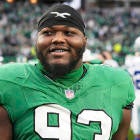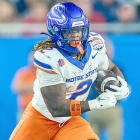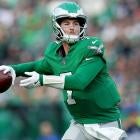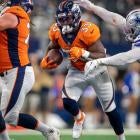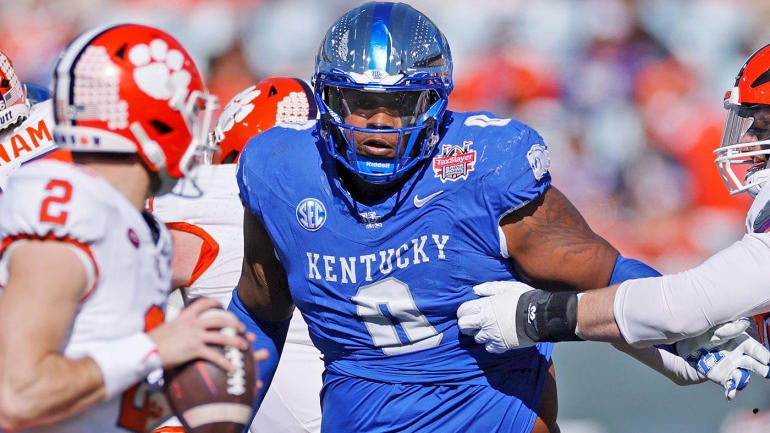
Now that Aaron Donald is retired, Dexter Lawrence has a legitimate case as the best defensive tackle in football. Sure, Chris Jones is probably a better, pure pass-rusher. But the Giants' 6-foot-4, 340-pound nose tackle plays more effectively against the run and is a nightmarish upfield rusher in his own right.
Lawrence's emergence from quality first-round pick in 2019 to undisputed superstar playing head-up on the center most of the time came precisely when we all were ready to label nose tackles -- and many classic defensive tackles that aligned one gap over inside -- strictly two-down, run-halting specialists once and for all.
While Lawrence feels unicorn-ish because 95% of the rest of the nose tackles in football fit that limited archetype, there is another gargantuan nose tackle prospect with Lawrence-ian athleticism and collegiate production whose set to play what will almost assuredly be his final season in the SEC in 2024.
He's Deone Walker of Kentucky, and, at 6-6 and 348 pounds, he led all defensive tackles in Division I with 51 quarterback pressures in 2024. That rarely, if ever happens. And it's 10 clear of Lawrence's career high at Clemson.
I planned to demonstrate Walker's astoundingly freakish combination of size, width, nimble feet, and athleticism, rep-by-rep. This cutup I found on Twitter/X does the job much more efficiently. Behold.
Deone Walker’s tape is NIGHTMARE FUEL 🤯
— NFL Draft Files (@NFL_DF) May 13, 2024
Imagine having to block a 6’6, 350lb d-lineman who can play as a standup edge rusher… pic.twitter.com/44BWBzS1r7
Now, in every draft, there are a few enormous nose tackles many marvel at because of their movement capabilities relative to their size. Essentially none of them move -- and use counter moves -- like what you just witnessed in that video. And more critically, none have been as productive rushing the passer as Walker was in the SEC, the Triple A of the NFL.
Because of that, we're clearly onto something with Walker as a legitimate and unique draft prospect, but he can be more than just those things. He can be legitimate, unique, and a valuable draft prospect. Yes, even as a nose tackle.
The NFL is in the throws of a defensive tackle revolution. The stocky trench players primarily known for their run-stopping efforts and scoring the rare Big Man Touchdown are growing exponentially in importance as the logical counter to the way offenses have quietly been trending right before our eyes.
And the idea of the growing value at defensive tackle isn't just an opinion. The money bears it out. And nothing speaks louder than money, especially in the NFL.
Entering the 2024 season, there are 13 defensive tackles making at least $20M in average per year, the same number as the edge-rusher spot, a fact that would've seemed implausible at any point over the last decade or earlier.
And check this -- below is the average NFL depth of target (aDOT), by season, since 2006.
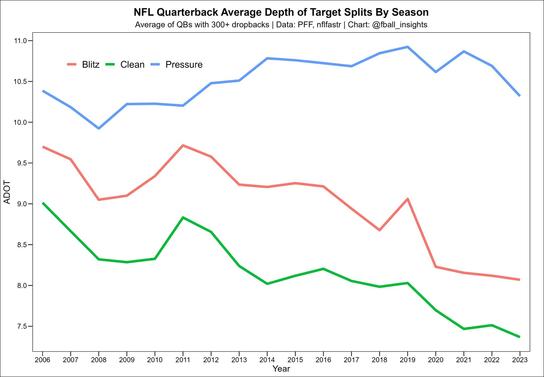
Staggering, right? Scheming players open and the quick-passing game have literally never been more crucial and prevalent in the history of the NFL.
The ball has been coming out faster and faster for nearly 20 years now. And for as complicated as NFL schematics and game plans can be, sometimes Occam's Razor, stating "the simplest solution is usually the best one," hits home with coaches. With defensive tackles being situated closest to the football before the snap, those who can earn "quick" pressures are treasures.
Here's the top of the list of pressures in 2.5 seconds or less after the snap among defensive tackles in 2023.
| Rank | Defensive Tackle | Pressures in under 2.5 seconds | |
|---|---|---|---|
| 1 | Aaron Donald | 51 | |
| 2 | Chris Jones | 47 | |
| 3 | 43 | ||
| 4 | Dexter Lawrence | 42 | |
| 5 | 40 | ||
| 6 | 39 | ||
| T7 | 37 | ||
| 8 | 35 | ||
| T9 | 34 | ||
| 10 | 33 |
While the likes of Myles Garrett, Nick Bosa, Maxx Crosby, and Aidan Hutchinson all had more than Donald's 51 "quick" pressures, and many more edge rushers are dotted throughout this statistic than defensive tackles, when double-team rate is considered, it crystalizes as to why those quick pressures from defensive tackles are precious in today's NFL.
Of course, simply based on their pre-snap alignment with many more bodies on either side of them, defensive tackles naturally see considerably more double teams than those specimens flying around the edge.
Check this end-of-season chart from ESPN's Seth Walder on qualifying defensive tackles and their double-team rates on the X axis:
Double team rate at defensive tackle (x) by pass rush win rate at defensive tackle (y) for the 2023 regular season.
— Seth Walder (@SethWalder) January 15, 2024
(ESPN Analytics / NFL Next Gen Stats) pic.twitter.com/TN9blAqqf8
More than 20 defensive tackles listed had a double team rate over 60% during the 2023 regular season. Even D.J. Jones, the player with the fourth-lowest double-team rate at defensive tackle was doubled 50% of the time.
In short, defensive tackles jobs are challenging, because more often than not they have to beat multiple blockers en route to the quarterback.
Now check that same chart for edge rushers:
Double team rate at edge (x) by pass rush win rate at edge (y) for the 2023 regular season.
— Seth Walder (@SethWalder) January 15, 2024
(ESPN Analytics / NFL Next Gen Stats) pic.twitter.com/EsvTl8YnQE
Micah Parsons, the most doubled (qualifying) edge rusher during the 2023 campaign, didn't even get doubled 40% of the time. And there were more than 20 edge rushers who faced an extra blocker less than 20% of the time last year.
Drastic difference along the defensive line.
All of that data is to suggest that defensive tackles are figuratively worth their weight in gold for their respective NFL teams. More specifically, it means that a 6-6, 340-plus pound nose tackle who can genuinely get to the quarterback at close to the same rate as an edge rusher should not and likely will not be undervalued in the draft simply because of the vast majority of players at his position are only on the field for two downs.
If Walker performs at a level comparable to last season or either builds on his sheer pressure volume or increases his efficiency -- his pressure-creation rate was 12%, which clears the 10% threshold at the position for a high-level rusher -- then we should take him seriously as early-to-mid first-round pick in the 2025 NFL Draft.
Because right when we thought defensive tackles -- and specifically nose tackles -- were becoming obsolete artifacts in a pass-centric league, clubs have realized how essential they can be to combat the way most offenses want to move the football through the air.










